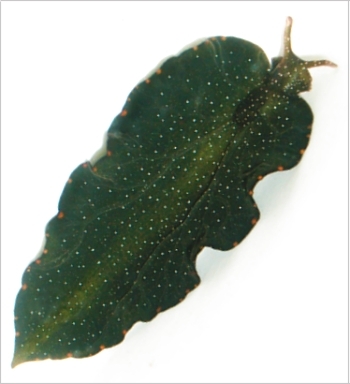
Elysia bangtawaensis
Swennen, 1997
Order: SACOGLOSSA
Superfamily: ELYSIOIDEA
Family: Elysiidae
DISTRIBUTION
Known from mangrove swamps in Thailand and northeastern Australia.
PHOTO
Locality: Coolangata area, 5-10 cm deep, New South Wales, Australia, Pacific Ocean, 28 July 2007, Intertidal muddy creek draining mangrove swamp. Length: 35-43 mm. Photographer: Gary Cobb.
Found in the upper reaches of mangrove swamps, E. bangtawaensis rests with its parapodia lying flattened out, making the animal look like a fallen mangrove leaf.
This species of Elysia has relatively large, thin parapodia. It is uniformly dark green with a series of 12-40 prominent, reddish orange spots along the margin of the parapodia. Scattered over the body and the parapodia are opaque white spots of varying sizes and some small reddish orange specks. It seems similar in size, shape and behaviour to Elysia leucolegnote.
First described from southern Thailand, its presence in southeastern Queensland and northern new South Wales would suggest it has a wide distribution in southeastern Asia and northern Australia.
- Swennen, C. (1997) Two new gastropods, Elysia bangtawaensis and E. siamensis from southern Thailand (Opisthobranchia, Sacoglossa, Elysiidae). Bulletin Zoölogisch Museum, Universiteit van Amsterdam 16 (6): 34-38.
Rudman, W.B., 2007 (August 8) Elysia bangtawaensis Swennen, 1997. [In] Sea Slug Forum. Australian Museum, Sydney. Available from http://www.seaslugforum.net/find/elysbang
Related messages
Re: Elysia bangtawaensis from India
April 23, 2010
From: Vishal Bhave
Concerning message #22746:
Dear Bill,
Just want to share ! Elysia bangtawaensis was reported in 2009 from Goa. in a publication entitled :
Elysia bangtawaensis Swennen (Nudibranch) from the mangrove habitat of Mandovi estuary, Goa (central west coast), India (2009)
It is available at: http://en.scientificcommons.org/43784792
Thanks !
Vishal Bhave
vishalbhave@gmail.com
Bhave, V.J., 2010 (Apr 23) Re: Elysia bangtawaensis from India. [Message in] Sea Slug Forum. Australian Museum, Sydney. Available from http://www.seaslugforum.net/find/23555Dear Vishal,
Thanks for the reference. I note they wrongly call Elysia a 'nudibranch'. It is of course a sacoglossan. Both sacoglossans and nudibranchs are opisthobranchs [= seaslug], but not all opisthobranchs are nudibranchs!
- Jagtap, T.G., Shenai-Tirodkar, P.S., Savant, S.B., Kulkarni, V.A. & Ansari, Z.A. (2009) Elysia bangtawaensis Swennen (Nudibranch) from the mangrove habitat of Mandovi estuary, Goa (central west coast), India. Current Science, 96(1): 30-33.
Best wishes,
Bill Rudman
Re: Elysia bangtawaensis from India
November 4, 2009
From: Apte Deepak
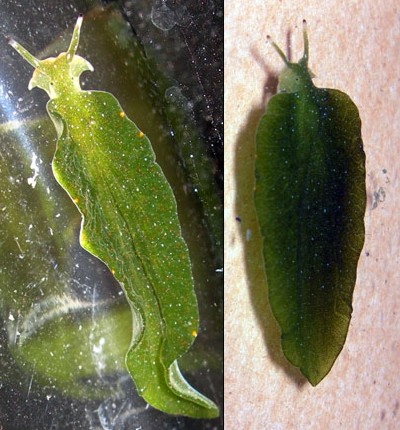
Concerning message #20377:
Dear Dr. Rudman
We recently got large number of Elysia bangtawaensis. I thought of sharing it on the Forum
Locality: Mumbai, 0.1 m, Maharashtra, Arabian Sea, 26th October 2009, Mangroves. Length: 20 mm. Photographer: Deepak Apte.
Regards
Deepak Apte
India
spiderconch@gmail.com
Apte, D.A., 2009 (Nov 4) Re: Elysia bangtawaensis from India. [Message in] Sea Slug Forum. Australian Museum, Sydney. Available from http://www.seaslugforum.net/find/22746Dear Deepak,
This is an interesting find. Originally reported from Thailand, and quite recently from eastern Australia, I think yours is the first discovery of the species from anywhere west of Thailand. It is a little ironic that just as I have been discussing possible colour variation in Elysia hirasei from India and Japan [see message #22747] you provide us with an example of an Elysia which shows no obvious colour variation from India down to eastern Australia.
Best wishes,
Bill Rudman
Elysia bangtawaensis from Cairns, nthn Queensland
September 7, 2009
From: Andrew Mitchell
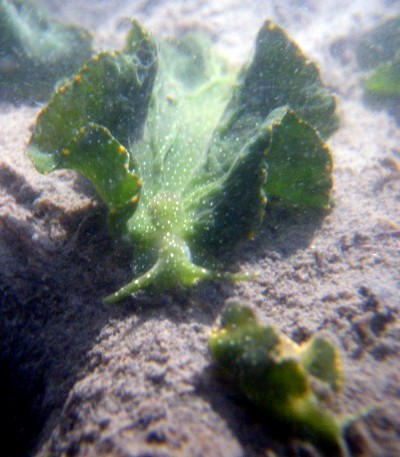
Concerning message #20377:
These sea slugs are the first of their kind that I have seen, despite having spent much time in mangrove habitats. I think that a nearby sewage treatment plant may increase algal growth and enable the slugs to thrive in this system. Huge numbers grazing gastropods occur in the near by mangroves (Telescopium and Terebralia ).
The underwater photo was taken in situ using a compact underwater camera. As the habitat is dark and the slugs crowd the surface and any movement by yourself or the gobies and crabs that share the creek stir up sediment, photography is difficult. Total population seen would be 300 animals in 10 m of creek. The slugs are clustered. The dots on the back of the slug appear bright metallic blue in the field.
Locality: Moon River, Yorkeys Knob, Cairns, Intertidal, Queensland Australia, Pacific Ocean, Coral Sea, 05 September 2009, Small channel in back swamp, soft sandy mud. Length: ~30 mm. Photographer: Andrew Mitchell.
Andrew Mitchell.
Andrew.Mitchell@westnet.com.au
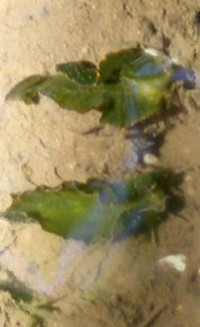
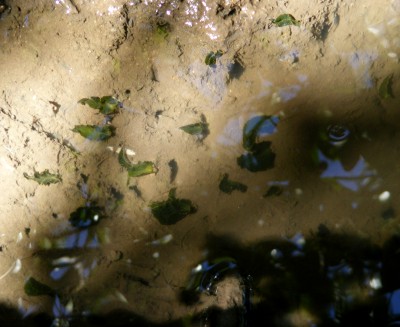
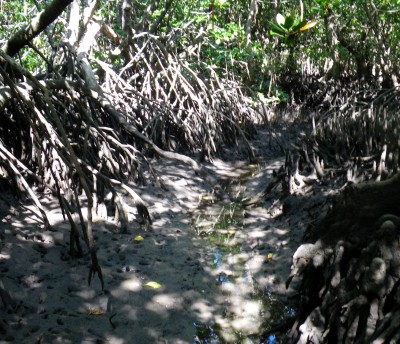
Dear Andrew,
This is an interesting find. The previous Australian records of Elysia bangtawaensis were from nthn New South Wales and sthn Queensland so your record from nthn Queensland help fill the large gap between sthn Queensland and the only other known populations in Thailand.
It would be interesting to know more about the biology and natural history of this species.
Best wishes,
Bill Rudman
Re: Elysia bangtawaensis
August 10, 2007
From: Skip Pierce
Hi Bill
I do not have anything useful to contribute to the messages on E. bangtawaensis, however, the resemblence of the external morphology between it and Elysia chlorotica is remarkable indeed. Really, at least from what I can make out in the photos, other than the few larger orange spots at the edges of the parapodia (and, generally, I do not think colored spots are a meaningful taxonomic characterstic in elysiids), I don't think an E. chlorotica label (in the absence of geography, egg masses, etc, of course) would have been a surprise. Is the food of E. bangtwaensis known??
Skip
pierce@cas.usf.edu
Pierce, S.K., 2007 (Aug 10) Re: Elysia bangtawaensis. [Message in] Sea Slug Forum. Australian Museum, Sydney. Available from http://www.seaslugforum.net/find/20443Dear Skip,
I agree it looks like E. chlorotica - but I guess you don't have much choice if you are going to evolve into a leaf ! I know colour is not all its sometimes cracked up to be in sacoglossan identification, but I feel obliged to temper your comment about colour spots by saying that colour differences, like anatomical differences, can be very important, but only after they have been rigorously evaluated. Unfortunately too many species in the past were based on one, or a few animals, so there was no understanding of colour variability between individuals, or of colour changes which occur during the life of an individual. And then of course there are the species which have been described from preserved decolourised specimens - a practice which I find incomprehensible.
Concerning its food - I don't think Swennen mentioned its food, but I will check next time I'm at the museum.
Best wishes,
Bill Rudman
Re: Elysia bangtawaensis in nthn New South Wales
August 10, 2007
From: Kathe R. Jensen
Concerning message #20439:
Dear Bill & Gary,
I think this species also occurs in India. While I was working in Thailand someone sent me 2 not very focused pictures of an Elysia from India, which looks very much like this one. If I remember correctly the person wanted to know whether it was Elysia leucolegnote because it had been collected in a similar habitat. I lost all my e-mail correspondance when they closed my account less than a month after I went back to Denmark, so I cannot trace back the original message, but I do have copies of the pictures.
Greetings,
Kathe
krjensen@snm.ku.dk
Jensen, K.R., 2007 (Aug 10) Re: Elysia bangtawaensis in nthn New South Wales. [Message in] Sea Slug Forum. Australian Museum, Sydney. Available from http://www.seaslugforum.net/find/20444Thanks Kathe,
Bill Rudman
Re: Elysia bangtawaensis in nthn New South Wales
August 10, 2007
From: Gary Cobb
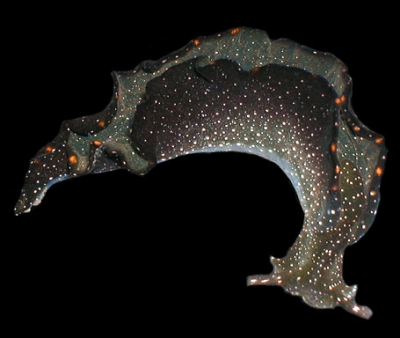
Concerning message #20377:
Hi Bill and everyone!
I thought you might like more photos of this wonderful animal. Including it's egg mass which is covered with silt. There were hundreds of these.
Locality: Coolangata area, 50-100 mm, New South Wales, Australia, Pacific Ocean, 28 July 2007, Intertidal muddy creek. Length: 35-43 mm. Photographer: Gary Cobb.
Cheers
Gary Cobb
gary@nudibranch.com.au
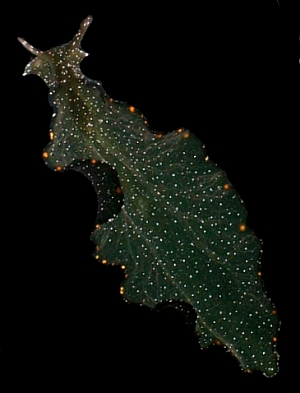
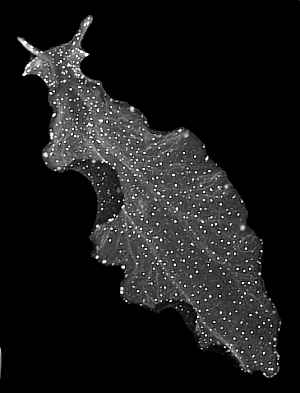
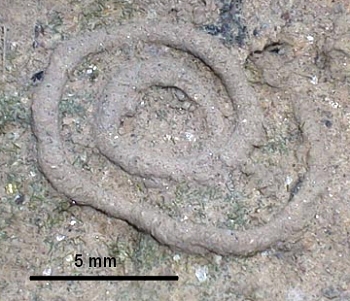
Thanks Gary,
It is a spectacular animal. I have included a grey version of the open parapodia because I think it shows the arrangement of the branching blood vessels more clearly than in the colour version. The arrangement of these vessels has been used by some authors to differentiate species.
If the egg ribbons are plentiful it might be intersting to scrape away the silt to see what the eggs look like - both colour and size, and whether they have extra-capsular yoke.
Best wishes,
Bill Rudman
Elysia bangtawaensis in nthn New South Wales
August 9, 2007
From: Gary Cobb
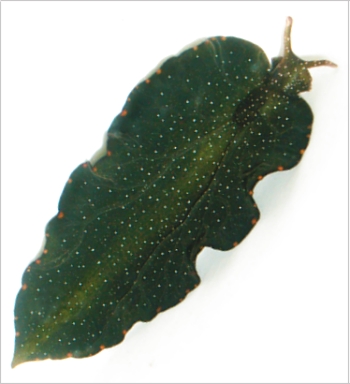
Hi Bill and everyone!
Well things are hotting up here! A species of Elysia was found by a water testing employee of the new Tugun road bypass being built in southern Queensland and northern New South Wales. There is a drainage creek that flows into the Cobaki Broadwater and about 100 m in from the broadwater these 'leafy' Elysia thrive. There is plenty of algae there to eat. They have been seen in an area of about 20 meters of creek. It is amazing how this species looks like a leaf on the bottom!
Locality: Coolangata area, 50-100 mm, New South Wales, Australia, Pacific Ocean, 28 July 2007, Intertidal muddy creek. Length: 35-43 mm. Photographer: Gary Cobb.
Richard Willan has identified them as Elysia bangtawaensis Swennen, 1997 and says...
"I just got Swennen's paper today as a photocopy and the text leaves little doubt that's what it is. This is what it says about the colour: "The colour of living Elysia bangtawaensis appears uniformly dark green with a series of 12-40 prominent, reddish orange spots along the outer margins of the parapodia. Less prominent opaque white spots and still smaller, white and reddish orange specks of varying size are visible on the dorsal and ventral sides of the body, including parapodia, foot, pericardium and rhinophores."
As far as I know, Elysia bangtawaensis has only been found previously in Thailand "near the village of Bang Tawa, about 11 km west of Pattani" (this is the type locality). I like what else Swennen has to say about this locality "The species is named in honour of the people of Bang Tawa village, where the first specimens were discovered in the mangrove forest. [The villagers have protected their forest against the shrimp culture companies that are converting large parts of the natural productive and complex coastal ecosystems into 'bio-industrial deserts'. ]"
Of course the specimens from Tugun are not a new record for Australia, or for southern Queensland, because Helene Laws collected some and sent them to Bob Burn 30 years ago (these specimens are now lost unfortunately). Even though (maybe because) they are named, this population of Elysia bangtawaensis has special conservation significance in that it represents the only known population of this species anywhere in Australia and the habitat looks very vulnerable to disturbance."
Thanks and happy branching,
Gary Cobb
gary@nudibranch.com.au



Dear Gary,
Thanks for this interesting find. There seem to be a number of these large leaf-like species which inhabit the upper reaches of mangrove forests. I was sent photos of a species about 10 years ago which didn't fit either of Swennen's species Elysia bangtawaensis or E. siamensis but was asked not to post them on the Forum until the finder decided what they were going to do. Unfortunately I have heard nothing from the 'finder' since.
I wonder if Richard's mention of earlier finds of E. bangtawaensis in your area are the finds referred to by Bob Burn (1998) as E. leucolegnote which is another large mangrove inhabitant. Burn notes "it can be found in the mangroves along the tidal creeks of Moreton Bay, southern Queensland". He describes it as "a big dark green species with a white margin" which certainly fits E. leucolegnote, but I dont know if his colour description is from Jensen's description of E. leucolegnote, or from his notes on Moreton Bay specimens. It seems to me that needs to be sorted out before you man the barricades to stop the road through the mangroves.
-
Burn, R.F. 1998. Order Sacoglossa. Pp 961-974. In: Beesley, P.L., Ross, G.J.B. & Wells, A. (eds). Mollusca: The Southern Synthesis. Fauna of Australia, Vol 5. CSIRO Publishing: Melbourne. Part B 565-1234.
-
Swennen, C. (1997) Two new gastropods, Elysia bangtawaensis and E. siamensis from southern Thailand (Opisthobranchia, Sacoglossa, Elysiidae). Bulletin Zoölogisch Museum, Universiteit van Amsterdam 16 (6): 34-38.
Best wishes,
Bill Rudman
